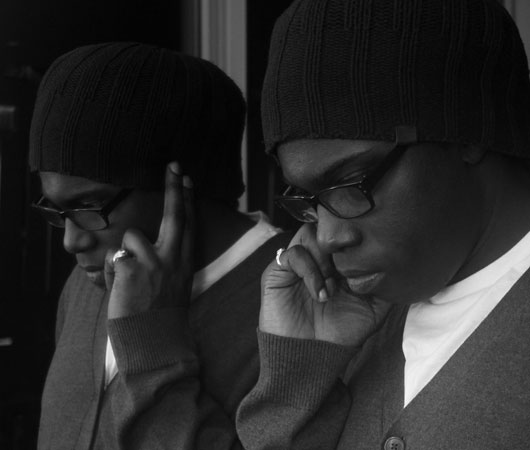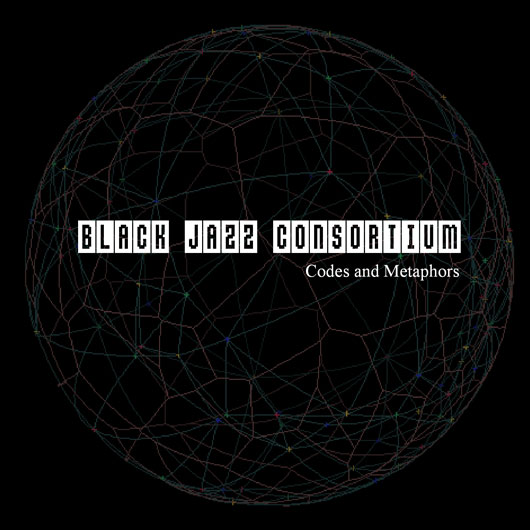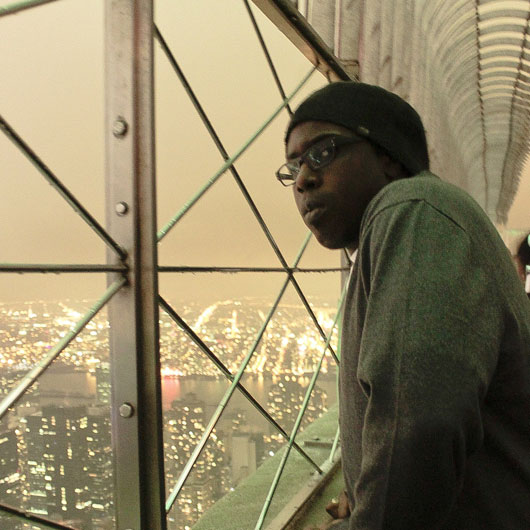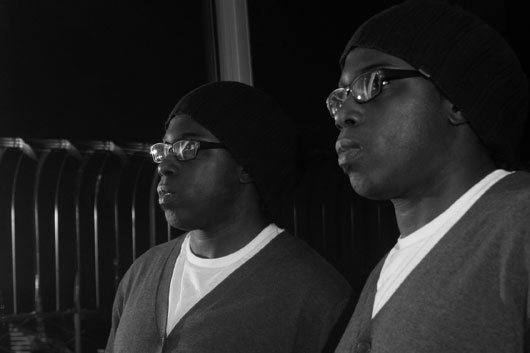Black Jazz Consortium: The Veteran NYC Producer Traces His Musical Evolution and Talks About Going Digital
Words: Derek Opperman
“Electric Ladyland? Jimi Hendrix? You know how he does that whole solo backwards? I just like that sound, and I like to try it on different things and see what it does,” says Fred Peterkin. The DJ and producer better known as Fred P and Black Jazz Consortium is attempting to explain the recurring theme of reversed samples in his music, and, in the process, he shows a little bit of where his particularly deep style of house comes from. It’s a sound characterized by dense textures, smeared samples, and often off-kilter rhythms that subliminally evokes Peterkin’s own complex relationship with music—a New York story with 30 years of near-misses, false starts, and disappointments before he finally found his recent success. With three LPs now behind him, his latest, Codes and Metaphors dropped this week.
Peterkin grew up in Flatbush, Brooklyn and, like many of his peers, was enamored with radio. As it turned out, the airwaves were the medium by which he first experienced house music. He says, “It was something that was played on the radio all the time. This was before the internet and all that stuff. It was basically this station 98.7 KISS FM, and they’d play club remixes and disco versions by Larry Levan of popular R&B songs that were out at the time. And these were the records that would be played at family functions—it was the most popular station in New York City.”
Around the same time, he found himself going deeper into New York’s hip-hop scene. In junior high school he got into b-boy culture, becoming a breakdancer and running with a group of friends who later, in high school, would begin exploring the city’s house dancing meccas. “It started in the Pyramid Club in the Lower East Side. From there, I went with a friend from my neighborhood and we started looking for places to go dance cuz we were both very much into the music. It was more so for the comradery of the dancing and being a part of the circle—that was a big deal because it was relative to a b-boy battle and the breaking and popping we did at the time. So it would be Pyramid, Sound Factory, Red Zone, and the Tunnel. Those were the main places we went.” Yet even though he was a regular attendee of some of New York’s most hallowed dancefloors, he wasn’t then particularly into club culture itself or even DJs. “I was more attracted to the social aspect in the early days; I wasn’t so much into club culture because I wouldn’t go to a club without my friends. In fact, sadly enough, I only knew a couple DJs that I followed when it came to house music. And that was Junior Vasquez, Roger Sanchez, DJ Disciple, Tony Humphries, Kenny Carpenter, John Roberts, those were the main ones that I used to look for when I used to go out and buy tapes. But I mean, I was heavily into hip-hop and dance music was the subculture.”
And it would be his infatuation with hip-hop that would lead to his first forays in music production. At the age of 15, he got ahold of some tape decks and tried his hand at making beats. Apparently, even at that early stage, his sound had that certain otherworldly quality that’s come to define his music in the years since. He describes that music as, “Kinda far out, a lot of that stuff was really spacey and experimental.” However, the production bug properly caught him a little later, when his cousin, a lyricist and MC, worked out a deal for the two of them to get some studio time at Platinum Island studios. They started working on a demo together and Peterkin soon found a mentor in one of the studio’s house engineers. He says, “That’s the way I actually got my education, because through this guy, I pretty much became a studio rat for the next four years. I’d take the L train—last stop—and go all the way to the city and be at Platinum Island watching the engineers do their thing. Just night and day.”
But none of the music from this time would ever see public release. Peterkin and his cousin put together an impressive demo and were even offered a six-figure record deal by a major label. Ultimately though, things didn’t work out, as he explains, “It was a timing issue. That was when gangster rap was becoming a big thing, and they wanted us to go in that direction. The deal fell through because we couldn’t produce anything that was real on that level.” Peterkin’s frustration ultimately gave way to a dark period. “I went into such a deep depression. I sold all my gear, got a job doing security, and [said] ‘screw music.’ It was so heartbreaking because I couldn’t be myself. I was like, ‘forget it, I don’t want to do it.'”
Working as a security guard in Brooklyn, he slid downwards into the non-musical day-to-day. There he stayed for a time, but it was only a few years until music came back into his life, thanks to a chance meeting with an old friend named Jay Locke. He was a veteran DJ from Peterkin’s old neighborhood who had branched out from house music to discover the broken sounds of West London in the late ’90s. “It was like running into an old lost friend and we started to catch up,” Peterkin says. “He [had] recently came back from a trip to Europe and he’d bought a whole catalog of music, and he wanted to share it with me. He’d bring by compilation tapes of just the most amazing things. Everything like 4Hero, Spacetime Continuum, Kirk Degiorgio—everything I love today, this man introduced me to. Even though it wasn’t 4/4 dance music, it had all the elements of dance music that I love, with all those textures and sounds.” Finding himself newly inspired, he began to reassemble a studio to produce music, just for the love of it. He says, “I wasn’t into the mindframe of, ‘let me make something and release it.’ I was like, ‘let me make some stuff because I like to make music.'”
Like many of his prior projects, it was slow going at first. in fact, he wouldn’t have released anything if it wasn’t for the prodding of his girlfriend at the time. He explains, “That whole digital thing came about because my ex-girlfriend would say, ‘stop complaining and do something.’ I had some stuff I had made, and it was just sitting there on a hard drive. I decided to just give it away to see what would come from that.” But before he could do that, he needed a new name. His old moniker was tied too closely to his hip-hop days, and he wanted to remain relatively anonymous. “I didn’t want to have my real name attached to anything so I could see the honest reactions of people. It started out Brooklyn Jazz Consortium. The place I worked in Brooklyn was called the Consortium for Worker’s Education. I liked the word consortium because it means a bunch of different entities coming together for one purpose. And jazz is basically an American art form that’s kind of free and not stapled to one thing—and when it comes to free jazz, it’s open expression. And, I changed Brooklyn to Black because I moved to Queens and because I’m black.”
With a new moniker, he reached out to the internet as an outlet for his creative impulses. He says, “I uploaded it [my music] to Download.com, and it got the attention of Next Dimension music.” This was his first break, even if it was a modest one. He’d eventually release three digital EPs for the label before also releasing other material on similar netlabels Total Wipes and Gotta Keep the Faith. Even though there was some interest at this time, he still felt as though he wasn’t going anywhere. Frustrated once again, he started Soul People, his own imprint. This too floundered, as he says, “At the time I wasn’t working, I didn’t have a job, and I was going through some rough stuff personally. Music was my refuge and it still is. At the time, I was just releasing stuff to see what was out there, but what was out there was completely discouraging. The conclusion I came up with was that I would stop and really just dig in to find some civil-service job. But I decided to do one last effort and just make a love letter to house music. And that’s how RE:Actions of Light happened.”
That first album, pressed to CD, was a turning point for Peterkin. “My goal was to make at least a record,” he says. “Like one record. Cuz I’m a ’70s kid, I grew up on record culture. I just wanted to have my name on a record and say, ‘I made this, and that’s enough.'” Yet RE:Actions of Light wouldn’t turn out to be his last record after all. Instead, it attracted the attention of a number of contemporaries, who recognized something unique in its futuristically ambient dance grooves. New York DJ Jenifa Mayanja in particular was impressed, and she asked Peterkin for a remix. Eventually his work crossed paths with her husband Jus-Ed, the founder of Underground Quality. Peterkin says, “He liked what I did for her and wanted to put out some of my other tracks. So he got some of my tracks and put one of them on Unity Kolabo. He took me under his wing and showed me how to make records and what it takes to at least be consistent. I took what he said seriously, and since then, I’ve made a lot of records. My life kinda changed.”
From the lulls of depression to the heights of the touring circuit, one thing has remained constant, and that’s Peterkin’s desire to express his experiences via music. He refers to his albums as though they’re sonic diaries, containing music that isn’t always intended for the dancefloor; some of his production are simply efforts to capture his life. His most recent record, Codes & Metaphors, is no exception. Originally released as a series of three vinyl EPs, it marks an important transitional point for him and catalogues the turbulent ride he’s had since the release of The Incredible Adventures of Captain P, his previous record. “At the time, from the moment I did the first track, my life was changing immensely. I had a relationship of 10 years that just ended three tracks into it. I was more popular than ever on the touring circuit. On top of that, I had to learn how to leave the analog world and adopt the digital world. Which wasn’t something I was entirely secure with, but I had to learn how to embrace it.”
All these are undoubtedly major changes, but it’s the last point that he cites as having the most impact on the record itself. His sound was originally built from old-school outboard gear like his Akai S900, S2000, and Korg TR. In previous years, he used to glow about the creative accidents of hardware and was an often hard critic of producers who relied on the streamlined digital interface of a DAW. Yet when he broke up with his ex, he lost his permanent studio and was forced to completely embrace Ableton Live. He says,”I was anti-software up to that point, and I totally had to jump in with both feet. It was liberating, because it let me do everything in real time. I had 30 tracks running at the same time. But there are pluses and minuses. With hardware, you’re forced to stop and actually record what you have. With Ableton, you can continuously add and go as far as your imagination will take you. You can sit and work on one track all day long and do a thousand things with it. It’s like being in Candyland, but you need someone to tap you on the shoulder and say, ‘OK, you’ve been working for 10 hours on this one thing, and it’s great, but you need to finish this sucker.”
Even though half of the record was made on hardware in his studio in Queens and the other half was made on a laptop in hotel rooms between gigs, there’s still a cohesive quality to it all. Listening to the LP, it would be a pointless exercise to try to discern which parts were recorded with what equipment. Furthermore, his latest record feels like a natural step from the material he’s made before, the common element being his ability to conjure deep emotional landscapes with only a handful of well-placed elements. For instance, tracks like “Kleem (feat. Minako)” and “Even Greater (feat. Dakini9)” are both minimalistic house cuts that manage to create a kind of womb-like grandeur through repeating jazz chords, a stable four-on-the-floor kick, and heavy layers of dub delay. He says, “I never made it a secret. My music is relatively simple, but it’s mood intensive.”
Also new on the record is the presence of vocalists. While his prior releases have featured samples and snippets of spoken word, Codes and Metaphors is his first work to feature female singers front and center. This wasn’t something he planned on initially. “I’d never collaborated with anybody,” he explains. “It was a first for me. What set the tone was Minako with ‘Free Your Mind.’ She wrote the lyrics for that after a meeting we had. I [DJed] at 11 and she showed up and enjoyed the set. I gave her a CD and no sooner than when I landed did she send me these amazing lyrics to the track. I was blown away by how there was this synergy between us.” From there, he began working with others singers as well, and in each case, the singers themselves augmented his instrumentals with their own lyrics. All of it is appealing to him for a very specific reason, as he says, “The tracks remind me of the music I listened to in high school—dance music was more vocal back then.”
Even though Codes and Metaphors might have subtle differences, its contents still have that out-there feeling that runs throughout much of his work. Talking to Peterkin, one gets the sense that this is something he’s carried with him for a long time. When talking about jazz, he expresses his admiration for the free-jazz and fusion heavyweights who had the courage to follow their often chaotic and unorthodox artistic visions. But while speaking of his influences, he finishes on a note that perhaps some other artists could learn from. “It’s great to have influences, and it’s great to have people you admire. Maybe take examples from them, but ultimately, the best way to present anything creative is to honestly express yourself. That’s the only tip I can give, because that’s what I did. I kept it me as much as I possibly can, and with all the influences that are apparent, it’s still me being myself.”
(via xlr8l)
SD…to feed the soul!



